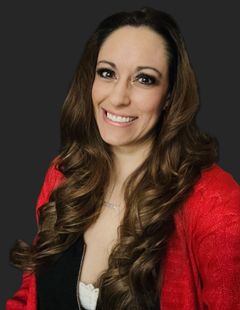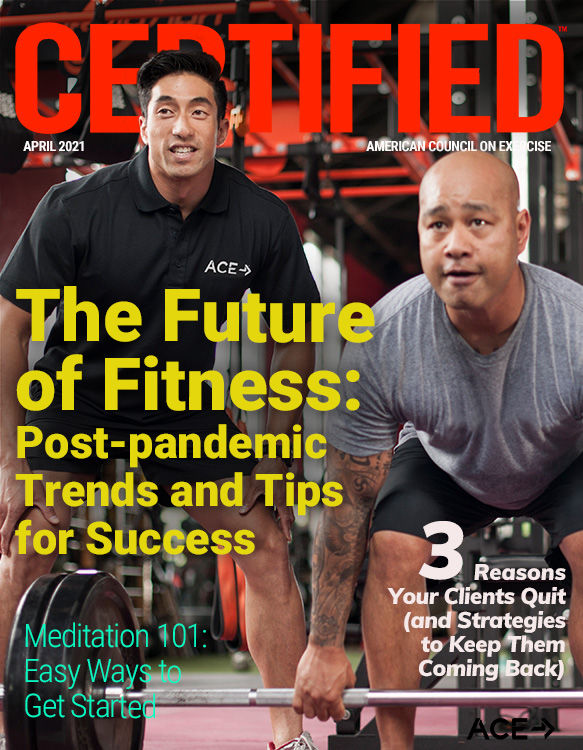
The health and fitness industry is fortunate to have a variety of high-quality, accredited and valued certification options that future professionals can pursue. To achieve success in a health- and fitness-related career, appropriate licensure and/or certification is essential for establishing credibility in their respective fields. However, as varied and valid as specific certifications are, one crucial characteristic missing from many study programs is a requirement to gain practical experience. Simply stated, there are some skills a textbook cannot teach as effectively as engaging in a hands-on experience can. As educational partners and established health and exercise professionals, we are uniquely positioned to bridge the gap between theory and practice that those who are new to the health and fitness industry experience. In doing so, these adult learners will gain a greater sense of confidence and will feel more adequately prepared to effectively work with their future clients.
It is my ultimate hope that by sharing lessons from my career as a long-time adult educator, I can enable other personal-training educators and mentors to create transformative learning experiences for students that transcends theories, concepts and principles.
Appreciating the Values and Recognizing the Needs of the Adult Learner
Over time, I have learned that instruction is a form of art and not just a science. Whether teaching and learning takes place inside a traditional college classroom, studio, technical school or community enrichment course, it is a practice that requires creativity and reflection. Given the diversity of its definitions, programs, settings and clientele, adult education is a profession and practice that values this very idea. As educational partners and mentors, we work with adult learners inside and outside a classroom setting to facilitate their learning and growth and to prepare them to be effective contributors to the health and fitness industry. Before we can prepare them and build the learning experience required to transform learners from novices to professionals, we have to first understand what the adult learner needs to learn and grow.
Adult learners come to the classroom with varying needs, interests and experiences. The adult learner is a unique and complex individual with specific needs that, when recognized, allow the adult to be both a learner and contributor to the classroom. Adults tend to be problem-centered and actively engaged in the learning process; they enjoy a challenge and seek to understand the relevance of a learning activity. Adults also enjoy the discovery of new information through self-directed learning activities and practical application opportunities. The adult learner’s search for knowledge often stems from the desire to be an ageless learner rather than a need to meet a specific course or program outcome. Overall, many adult learners view learning as an adventure in self-discovery. They possess a curiosity, a purpose, a self-defined direction and a desire to achieve a goal based on their own needs and interests. As adult educators, we have a responsibility to adapt our instructional practices to facilitate a learning process that is valuable and transformative—and, above all else, meaningful and relevant.
Observations From the Inside
In addition to working as a certified personal trainer and health coach, I have served as an exercise science higher education faculty member since 2003. Among the courses I designed and taught (and still teach) are subjects related to personal health, wellness, foundations of exercise science, lifestyle and weight management, nutrition, sports nutrition, human body systems, foundations of health coaching, methods of training and conditioning, and—the most personally meaningful course—personal trainer education.
Most recently, I partnered with ACE to assist in the design and development of the 5th and 6th editions of the Personal Trainer Curriculum. As part of that process, I worked to integrate formative assessments and engaging learning activities within the presentations to allow other educational partners to reimagine the delivery of the material and to encourage learners to critically think and apply the information associated with the various concepts in each lesson. In essence, the curriculum design itself is a departure from traditional lecture-based, brick-and-mortar-style instruction.
Over the past 18 years, I’ve seen a significant number of degree and certificate programs that are theoretically and scientifically sound but lack a practical component that can creatively, thoughtfully and fully prepare learners for the practice of personal training—a component adult learners both need and value. Consequently, many students would complete their course of study with a thorough understanding of the science and principles that guide personal training, but they often lacked the confidence essential to consistently apply those theories in a real-life, real-world setting with their future clients. This presents an issue we can collectively work to resolve as educators and fitness mentors.
Now, as I reflect on my own teaching experiences, I recognized where I missed opportunities to fully engage my adult learners in something beyond theoretical discussions. I began to recognize the chasm that was preventing my students from going forth with a high degree of self-efficacy that would otherwise naturally motivate them to take on their first client with excitement instead of reservation. I found a way to address that issue and lessen the gap and I’m so thankful I did. Now, I’m not suggesting that the following example completely solves the theory-to-practice gap or remedies other issues educators may face. Rather, the purpose is to provide an example that other educators can use as a place to begin the conversation. Perhaps in sharing this discovery, you, too, will find new ways to support and engage your adult learners as they pursue their health and fitness career.
Addressing the Gap Using a Practical Approach: An Example
About 10 years ago, I implemented a six-phase project that allows students to engage in the process of working with a new personal-training client from start to finish. As a result, students I’ve worked with left their academic programs feeling more confident and with something more tangible than a set of theories, concepts and principles to guide them in their future practice. This project permitted students to gain the experience necessary to build rapport, interview and screen, perform select fitness assessments, discuss results of those assessments, assist clients in setting SMART goals, address gaps in nutritional habits, design and implement an exercise program and modify that program as the client progresses. A summary of the project and its phases are below.
Personal Trainer Client Experience Capstone Project
This project is a two-semester experience. During the first semester, students are paired with another classmate and each engage in the role of personal trainer and client. In the second semester, students are paired with a volunteer client from the school’s staff. The first semester allows students to become familiar with each aspect of the project, while the second allows them to work with someone with whom they aren’t familiar and approach each phase with more confidence given that they had a “dry run” the semester before.
Capstone Project Objectives:
- Build rapport with a fitness client
- Collect and analyze health history information and seek medical clearance (if required)
- Analyze data to formulate a plan of action
- Assess physical-fitness levels—cardiorespiratory endurance, muscular strength, muscular endurance and flexibility—as well as body composition—the measurement of lean and fat tissue—of various individuals to establish a baseline
- Evaluate behavioral readiness to increase exercise adherence
- Analyze and modify Frequency, Intensity, Time and Type (FITT) to improve or maintain a client's physical-fitness level
- Develop a comprehensive exercise/physical-activity program
- Develop a comprehensive reassessment plan/timeline
Phase I: Client Meet and Greet
This phase serves as an initial rapport-building exercise. Students seek to understand their clients’ “why,” past experience with activity, interests, preferences, etc.
Phase II: The Interview: Client Prescreening and SMART Goal Setting
In this phase, students engage in an investigation effort to collect necessary health-history information. Forms used in this phase include the PAR-Q+, informed consent, health history and lifestyle inventory, exercise history and attitude questionnaire, and SMART goal worksheet. Students analyze the information collected and apply the appropriate preparticipation screening algorithm to determine if medical clearance is necessary. They discuss nutritional tracking with their clients and give them a three-day food log to complete as a journaling activity.
Phase III: Fitness Assessments and Baseline Data Collection
At this point, students select appropriate and relevant assessments to conduct with their clients and analyze and interpret the results of those assessments to establish a baseline for programming. The assessments are conducted over two separate sessions to limit overwhelming the client and to be mindful of the time constraints many clients experience.
Phase IV: Assessment Results Discussion and Nutrition Review
In this phase, students meet with their clients to discuss the collective results of the relevant assessments, revisit the client’s SMART goals, identify their preferences for exercise and movement, and review their schedule availability and time allotment for training sessions. This session also includes a summary of nutrition observations based on the food log they completed earlier, and potential for changes are explored using motivational interviewing techniques.
Phase V: Program Consultation and First Training Session
Clients are presented a draft of the workout program (which aligns with the clients’ stated goals) designed by their designated student personal trainer. The students take the client through the workout, demonstrating each exercise, providing a rationale for why the program is structured the way it is and explaining why specific exercises or activities were included. Clients have an opportunity to suggest changes and modifications. The student personal trainers then integrate suggested changes and plan for the subsequent training sessions with their clients.
Phase VI: Subsequent Training Sessions
This phase extends through the end of the semester and includes all face-to-face (or virtual) workout sessions with clients. Modifications and progressions are made throughout this period to present the client with new physical challenges as necessary.
Following the conclusion of the project, students engage in a reflective exercise in which they examine the pitfalls and successes they (and their clients) experienced during this project. Students present the culmination of their practical personal-training experience at the end of the semester. Students are given a packet of sample forms to use with future clients, which they can adapt and implement in their practice.
Integrating a Practical Experience
There are a variety of ways in which an instructor can infuse practical, hands-on learning experiences for learners. This is just one example of what I chose to do based on what I observed in my evaluations of student learning. The type of experience you choose to offer will be largely influenced by the dynamic you have in your classroom (or other training setting) and the needs of the learners you are influencing. It’s always a good idea to start with the end in mind and ask: “What do I want students to be able to do upon completing this course or study program?” Build the activity from there and use it to support the theoretical and scientific foundation of the curriculum.
When learners are encouraged to participate in project-based learning experiences, rather than instructor-dominated discussions and lectures, we maximize learner potential and ability, which keeps the stimulus alive long after the activity has concluded.
As you look forward to planning your next educational experience for your students, consider integrating a hands-on experience to elevate and enrich their learning experience.





 by
by 


